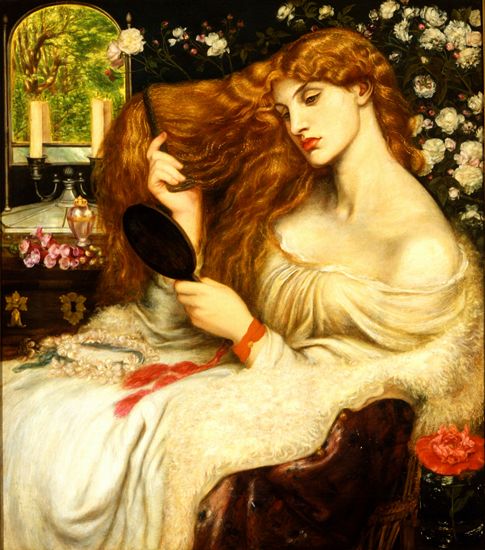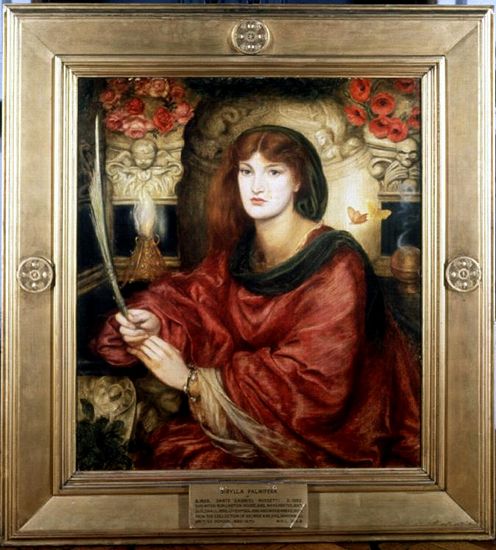Female Representation in 'Body's Beauty' & 'Lady Lilith'
Emily Brac & Katie Murray
1350
|
Dante Gabriel Rossetti created the poem Body’s Beauty and the associated painting Lady Lilith in a time and place where women had a specific role in society. The ‘ideal’ nineteenth-century English woman was submissive to any male influence in her life, always proper, and well behaved. With this poem and painting, Rossetti presents an alternative view on females in this society, one that will be explored through analysis and interpretation of this written and visual work. Body’s Beauty and Lady Lilith challenge the societal norms and expectations of women in the nineteenth-century. Rossetti does this by depicting a woman putting herself and her own needs before that of any man, by addressing the potentially negative aspects of women that society tends to repress, and by using religious tones for the use of comparison. Rossetti’s purpose in all this was to portray women as they truly are, which is much more complex than nineteenth-century society allowed them to be. |
An average nineteenth-century woman had many men to answer to in her daily life. This included all male members of her family, her pastor, eventually her husband, and any man who happened to be older than she in her community. Women, with an array of characteristics, feature prominently in Rossetti’s works@Ormond, Leonee. “Dante Gabriel Rossetti and the Old Masters”. The Yearbook of English Studies 36.2 (2006): 153-168. 6 Feb. 2011 < http://www.jstor.org.ezproxy.lib.ryerson.ca/stable/20479249>.. The proper English lady would always be submissive and obedient to any man that fit into any of these categories, and in Body’s Beauty Rossetti dares to present a woman that would not. The subject of the poem, Lady Lilith, is portrayed as a femme fatale, a woman who answers to no man and instead uses them for her own pleasure@McGann, Jerome J. “Scholarly Commentary: Body’s Beauty” Rossetti Archive (2008). 16 Mar. 2011 <http://www.rossettiarchive.org/docs/2-1867.s205.raw.html>. .
Of Adam's first wife, Lilith, it is told
(The witch he loved before the gift of Eve,)
That, ere the snake's, her sweet tongue could
deceive@Rossetti, Dante Gabriel. "Body’s Beauty." ENG 633: 19th Century Literature and Culture II Course Reader, First Edition. Lorraine Janzen (Toronto: Ryerson University, 2011).
Lady Lilith is referred to as a witch, to be seen as a threatening and haunting presence@McGann, Jerome J. “Scholarly Commentary: Body’s Beauty” Rossetti Archive (2008). 16 Mar. 2011 <http://www.rossettiarchive.org/docs/2-1867.s205.raw.html>. . She was the type of woman to get under a man’s skin, to ‘haunt’ him with her presence even after they had parted, and had the ability to deceive any man just by moving her lips. This image Rossetti has portrayed does not embody the stereotypical wallflower a proper nineteenth-century woman was designed to be. A lack of submission is a prominent theme in Body’s Beauty, as Rossetti said himself, “that self-absorption by whose strange fascination such natures draw others within their own circle … is about the most essential notion of the sonnet”@McGann, Jerome J. “Scholarly Commentary: Body’s Beauty” Rossetti Archive (2008). 16 Mar. 2011 <http://www.rossettiarchive.org/docs/2-1867.s205.raw.html>. . Lady Lilith is portrayed as a woman who tends to her own needs before that of any man, which again is challenging society’s ideology of the stereotypical female.
|
Body’s Beauty by Dante Gabriel Rossetti is riddled with religious
connotations. Lady Lillith supposedly Adam’s first wife. She refused to submit to Adam and fled
the Garden of Eden. Some mythology centers on Lady Lillith and her role as a sex
symbol and succubus. When Rossetti was painting this portrait to go along with
his poem Body’s Beauty, he clearly knew these ideas and portrayed them onto his
subject because he incorporated many temptress-like attributes. Lillith as shown as a very vain woman which was never an acceptable trait in a woman. She is looking into a mirror as she grooms herself because she knows she is beautiful and knows she has that to her advantage. Women in the 19th Century were not encouraged to boast about their looks and to be humble and quiet. Lady Lillith fought this interpretation head on by very obviously flaunting her porcelain skin and luscious hair@ "Lady Liltih." The Rossetti Archives. 28 January 2011. http://www.rossettiarchive.org/docs/s205.rap.html. |



